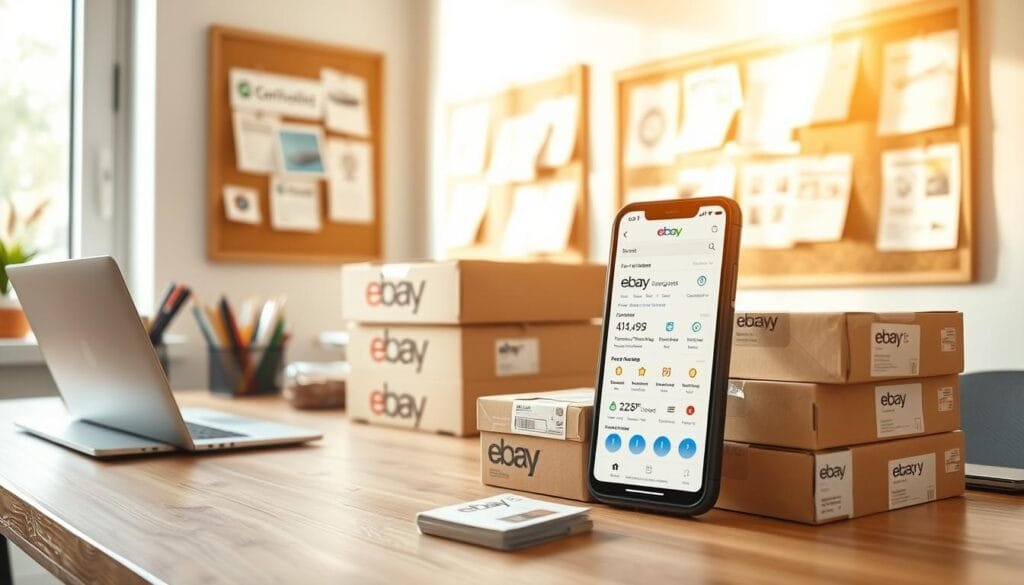Are you wondering if you can make money from items you no longer need? Selling on online marketplaces is a great way to earn extra cash. With the right strategy, you can increase your earnings a lot.
Thinking of your selling as a business can really help. Learning how ecommerce platforms work and making your listings better can get you more buyers. For more tips, check out webnetmagz.com to improve your selling skills.
Successful sellers on these platforms show that selling can be profitable. By treating it like a business and staying updated, you can start or boost your selling today.
Getting Started with eBay Selling

To start selling on eBay, follow a few easy steps. eBay is a big auction site for buying and selling online. You’ll need to set up your seller profile, understand fees, and find profitable areas to sell in.
Creating and Optimizing Your eBay Account
First, create a professional eBay account. Make sure your profile is filled out with the right info. Include a clear photo and a detailed bio about you and what you sell.
Setting Up Seller Preferences and Policies
Next, set up your seller preferences and policies. This means deciding on payment, shipping, and return policies. Being clear about these helps build trust with buyers.
Building a Positive Seller Reputation
Your reputation as a seller is key on eBay. To build a good reputation, focus on great customer service, fast shipping, and accurate item descriptions. eBay’s feedback system helps build trust with buyers.
Understanding eBay Fees and Pricing Structure
eBay charges different fees to sellers. These include listing, final value, and payment processing fees. Knowing these fees helps you price items right and stay profitable. Here’s a simple look at typical eBay seller fees:
| Fee Type | Description | Typical Cost |
|---|---|---|
| Listing Fee | Charged for listing an item | $0.30 per listing |
| Final Value Fee | A percentage of the sale price | 8%-12.5% |
| Payment Processing Fee | Charged for processing payments | 2.9% + $0.30 per transaction |
As eBay says, “knowing our fees helps you make smart decisions about listings and prices.”
“Sellers who understand eBay’s fee structure can better navigate the platform and maximize their profits.”
Finding Your Niche on eBay
Finding a profitable niche is key to success on eBay. Look for popular items, use your interests and skills, and check out the competition. eBay’s Best Match and Trend reports can show you shopping deals and what’s trending.
To begin, explore categories that interest you and see what’s hot. This helps you find opportunities and see what buyers want.
Sourcing Profitable Products for eBay

Finding profitable products is key to a successful eBay business. It requires a smart strategy. Sellers need to find items that are popular, cheap to source, and can be sold for a good price.
Selling Items from Around Your Home
Start by decluttering your home and selling items you no longer need. This is a cost-effective way to begin. Look for gently used clothes, electronics, and home goods.
Tips for selling household items: Take clear, well-lit photos. Also, write detailed descriptions of the item’s condition.
Thrift Stores, Garage Sales, and Estate Sales
Thrift stores, garage sales, and estate sales are great for finding secondhand items. Look for rare or brand-name items in good shape. Researching demand before buying is important.
- Visit thrift stores regularly to find hidden gems.
- Arrive early at garage sales to snag the best deals.
- Research estate sales in your area to find valuable items.
Wholesale and Retail Arbitrage
Wholesale and retail arbitrage can help grow your eBay business. Wholesale means buying in bulk from manufacturers or distributors. Retail arbitrage is buying low at retail stores and selling online.
Key to success: Know the market demand and pricing to make a profit.
Dropshipping and Print-on-Demand
Dropshipping and print-on-demand services let you sell products without inventory. They are great because they save money and effort.
| Method | Initial Investment | Logistical Effort |
|---|---|---|
| Dropshipping | Low | Moderate |
| Print-on-Demand | Low | Low |
| Wholesale | High | High |
Understanding each method’s pros and cons helps eBay sellers make smart choices. This aligns with their goals and resources.
Creating High-Converting eBay Listings

To boost sales on eBay, sellers need to focus on making listings that turn browsers into buyers. This means using several key strategies. These strategies make a listing appealing and visible on the online marketplace.
Taking Professional Product Photos
High-quality photos are key to making a good first impression. Good lighting and the right equipment can make a big difference. On an ecommerce platform like eBay, how your product looks is a major selling point.
Equipment and Lighting Tips
Investing in a good camera and proper lighting is important. Natural light is best, but a lighting kit can help if that’s not possible. This ensures your products look their best in the shopping deals section.
Photo Editing Basics
Editing your photos to adjust brightness, contrast, and saturation can make them more appealing. Use software like Adobe Lightroom or Photoshop for professional results. This step is key to creating a polished look that attracts buyers.
Writing Compelling Item Descriptions
A detailed and accurate description builds trust with buyers. Include all relevant details about the item, such as its condition, dimensions, and any flaws. This transparency is key to succeeding on an online marketplace where buyers can’t physically inspect products.
Setting the Right Price: Auction vs. Buy It Now
Pricing your item correctly is essential. Decide whether an auction or a fixed price is better for your item, considering demand and competition. Researching shopping deals and trends can help you make an informed decision.
Optimizing Listings for eBay Search
To ensure your listing appears in search results, use relevant keywords in your title and description. Understand eBay’s search algorithm to maximize your visibility on this ecommerce platform. By doing so, you can increase your chances of making a sale.
Managing Your eBay Business Effectively
As your eBay business grows, managing it well is key to staying ahead. This means focusing on customer service, shipping, handling returns, and keeping track of money.
Handling Customer Service and Communication
Great customer service is essential for a good reputation on eBay. Answer buyer questions quickly and be friendly. Use eBay’s messaging system to keep talks clear and easy to find. “Good customer service is not just about fixing problems; it’s about making buyers happy,” eBay says.
Shipping and Packaging Best Practices
Shipping and packaging well are key to happy customers. Look for shipping options that are both cheap and fast.
Cost-Effective Shipping Methods
eBay sellers should compare shipping rates to find the best deal. Think about using eBay’s shipping labels for cheaper rates and easier shipping.
Packaging Materials and Techniques
Good packaging stops items from getting damaged in the mail. Use strong materials and follow eBay’s packaging tips to meet standards.
Dealing with Returns and Difficult Buyers
Dealing with returns and tough buyers is part of selling on eBay. Have a clear return policy and solve problems fast.
“A fair return policy can help build trust with buyers and lower the chance of disputes,” eBay says.
Tracking Inventory and Expenses
To stay profitable, keep an eye on your stock and costs. Use eBay’s seller tools, like the eBay Seller Hub, to track your business and make smart choices.
Conclusion: Scaling Your eBay Success
As you grow your eBay business, focus on strategies that lead to success. Use eBay’s promotional tools and improve your listings to get more visibility. This will attract more buyers to your secondhand items.
It’s also key to expand your product lines and improve customer service. eBay’s large marketplace is full of chances to grow your business. Keep up with trends and best practices to stay ahead.
With hard work and smart strategies, you can make your eBay business bigger. Use eBay’s features and keep improving your listings. This will help you sell more and build a loyal customer base.











